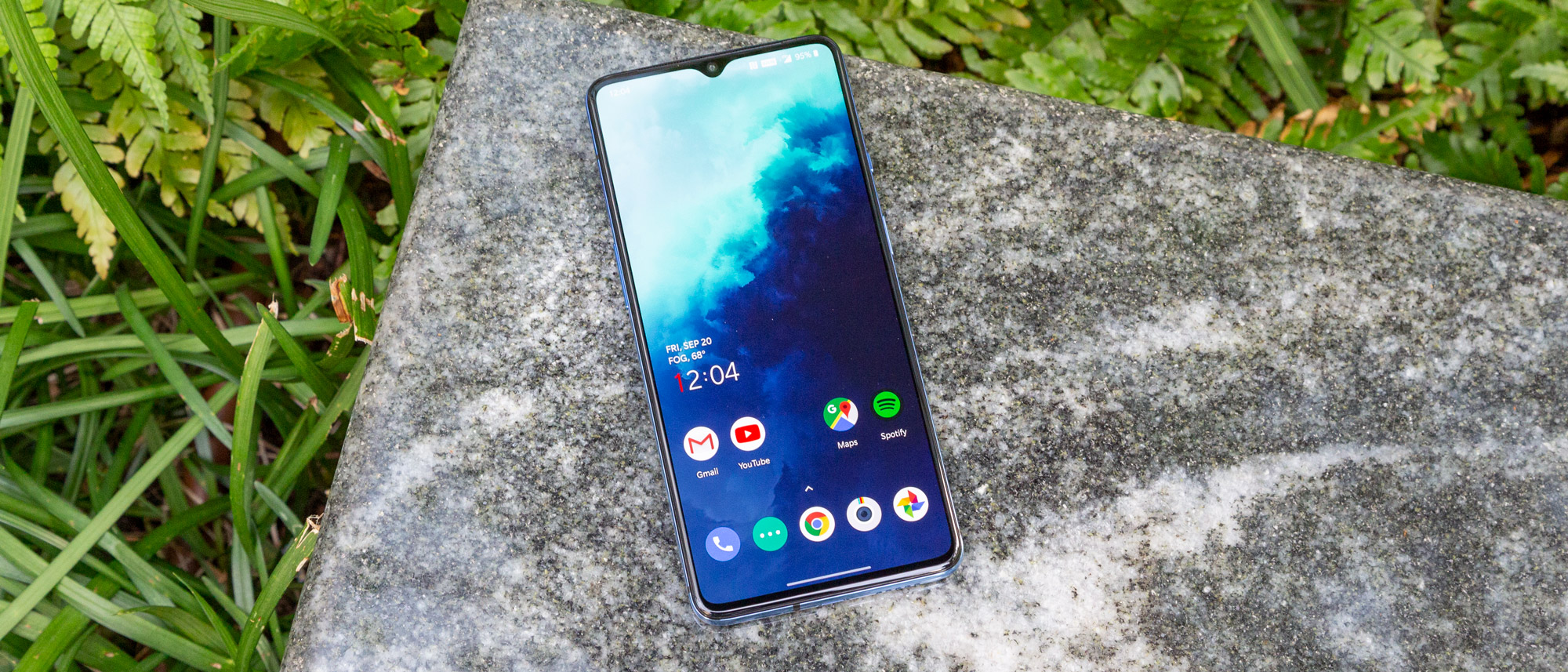Tom's Guide Verdict
The OnePlus 7T is the new Android phone to beat for the money, with a smooth 90Hz display, excellent performance and a fast-charging battery.
Pros
- +
Phenomenal value
- +
Great software
- +
Blistering performance
- +
Speedy charging
- +
Excellent build quality
- +
Macro mode works well
Cons
- -
Camera bump is an eyesore
- -
No wireless charging
- -
Only average battery life
Why you can trust Tom's Guide
The $599 OnePlus 7T includes many features that you would expect in a flagship phone in a trimmed-down and cheaper package. You get stunning performance, an advanced 90Hz display and super-fast charging in a device that costs several hundred dollars less than what you’d pay elsewhere. The OnePlus 7T's sheer value lands it on our best phones list., but it's not perfect.
If you’re after a class-leading camera or a pocketable design, the OnePlus 7T might not be for you. And some shoppers may want to wait to see what the OnePlus 8 has in store for users, as it's rumored to feature wireless charging and 5G. Overall, though, the OnePlus 7T remains one of the best Android phones you can buy.
OnePlus 7T price availability
The OnePlus 7T costs $599, and you can buy it from either OnePlus or T-Mobile in the U.S. (T-Mobile remains OnePlus' exclusive carrier partner in the U.S., although rumors suggest that Verizon could join their ranks next year.) In the UK, you'll pay £549 for the OnePlus 7T.
At T-Mobile, if you don't want to buy the OnePlus 7T outright for $599, you can pay off the phone in installments for $25 a month over 24 months. OnePlus lets you buy the phone via monthly payments, too, but over 12 months for $50 a month.
If you’d like to use the device on a network that isn’t T-Mobile, you could still spring for the unlocked model, which works smoothly with every GSM network, including AT&T. The OnePlus 7T of the best unlocked phones, period.
CDMA carriers are a bit of a different beast; the unlocked 7T will work on Verizon, but exclusively as an LTE-only device. That means Big Red subscribers will have to contact customer service and explain their situation to get the phone up and running on Verizon’s towers.
Unlike previous OnePlus handsets, there’s just a single configuration for the 7T, and it comes with 8GB of fast UFS 3.0 RAM and 128GB of storage. There’s no microSD slot on this phone, though 128GB should be enough for most users.
Get instant access to breaking news, the hottest reviews, great deals and helpful tips.
OnePlus 7T specs
| Price | $599 |
| Display (Resolution) | 6.55-inch Fluid AMOLED (2400x1080; 90Hz) |
| Rear Cameras | Triple: 48 MP (ƒ/1.6); 16 MP ultrawide lens (ƒ/2.2); 12 MP telephoto lens (ƒ/2.2) with 2x optical zoom |
| Front Camera | 16 MP |
| CPU | Qualcomm Snapdragon 855+ |
| RAM | 8GB |
| Storage | 128GB |
| microSD | None |
| Battery | 3,800 mAh with Warp Charge 30T |
| Colors | Frosted Silver, Glacier Blue |
| Size | 6.33 x 2.93 x 0.32 inches |
| Weight | 6.7 ounces |

OnePlus 7T design: That’s a big bump
On one hand, the OnePlus 7T resembles many of the Chinese firm’s previous phones, particularly with its teardrop notch, tall footprint and sloping 3D glass back.
But then you notice the ginormous circular rear triple-camera stack — how could you miss it — and suddenly, it’s clear that you’re looking at a new device.
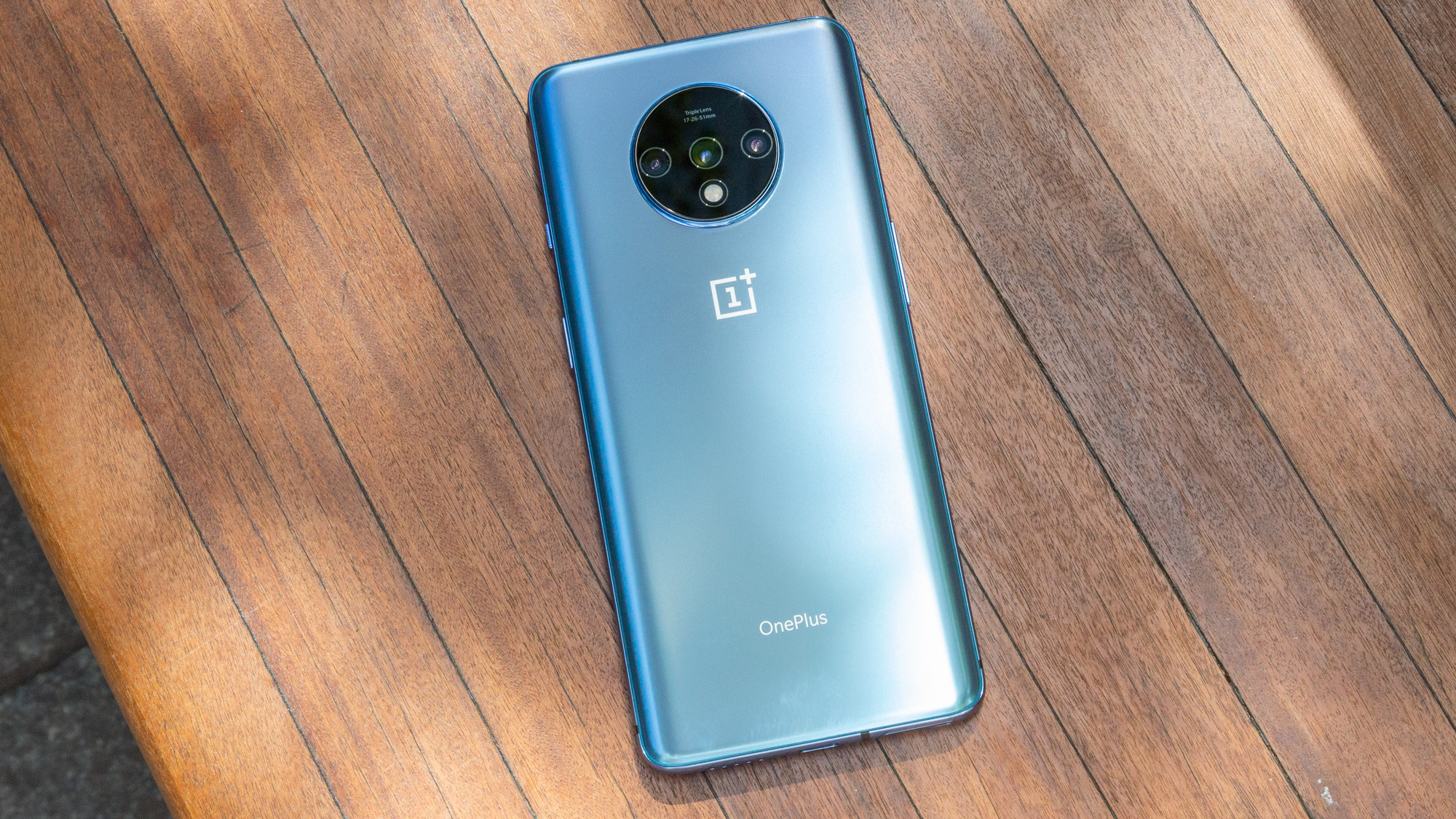
In typical OnePlus fashion, the fit and finish all around is superb, especially for what you’re paying. I love the company’s insistence in preserving that valuable alert slider, a habit I wish more Android phone makers would copy. The matte-effect glass on the back feels great to the touch, and the new Glacier Blue color on offer feels so much classier and tasteful to my eyes than the Nebula Blue option that the OnePlus 7 Pro launched with.
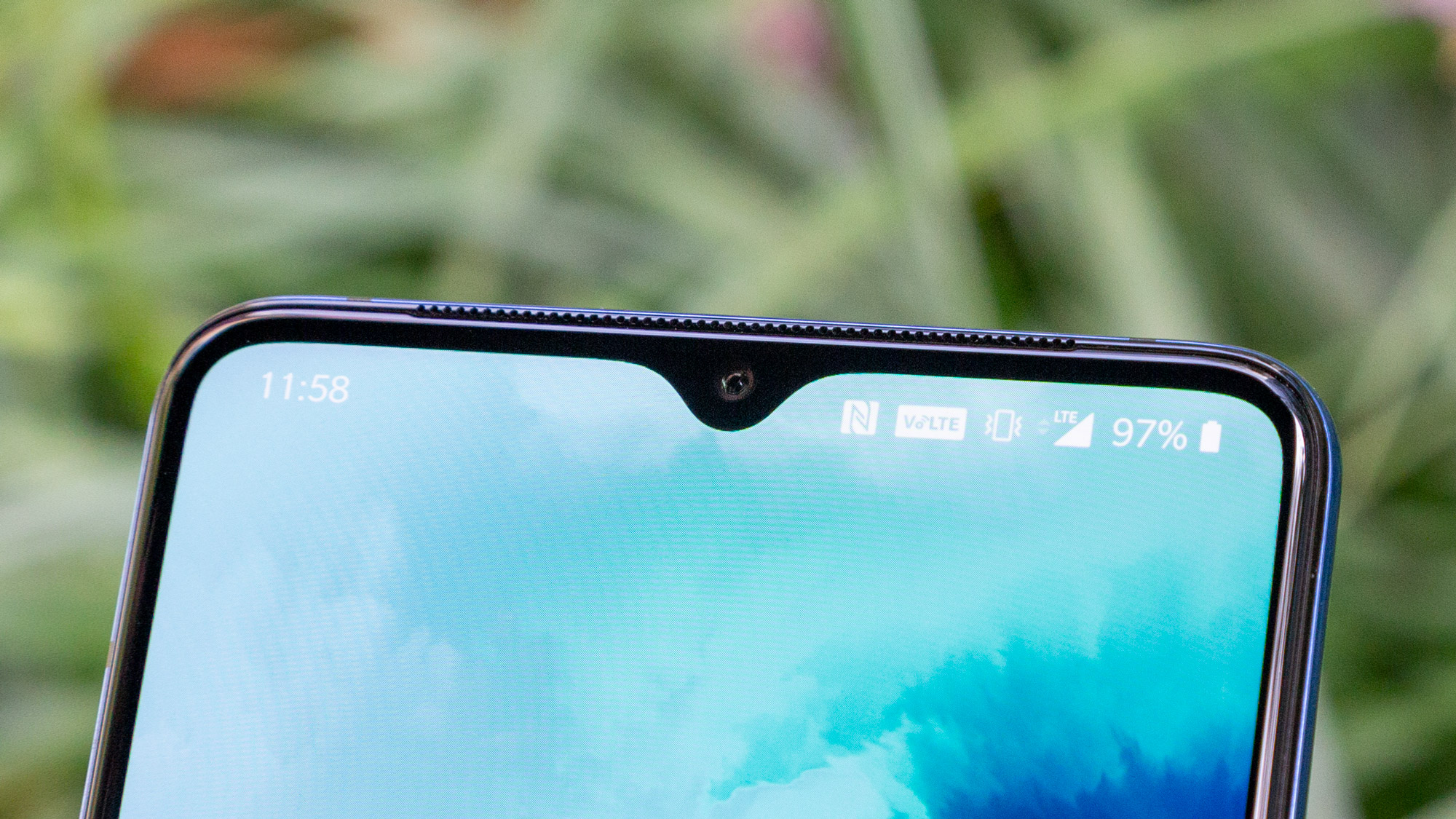
It’s not only a pretty handset, but a functional one too. OnePlus remains one of the only phone makers that ships its devices with both a pre-applied screen protector and a high-quality clear TPU case right in the box. It’s certainly the best pack-in case I’ve ever used, and helps mitigate the dearth of serviceable third-party accessories that inevitably comes with owning something other than an iPhone or Galaxy handset.
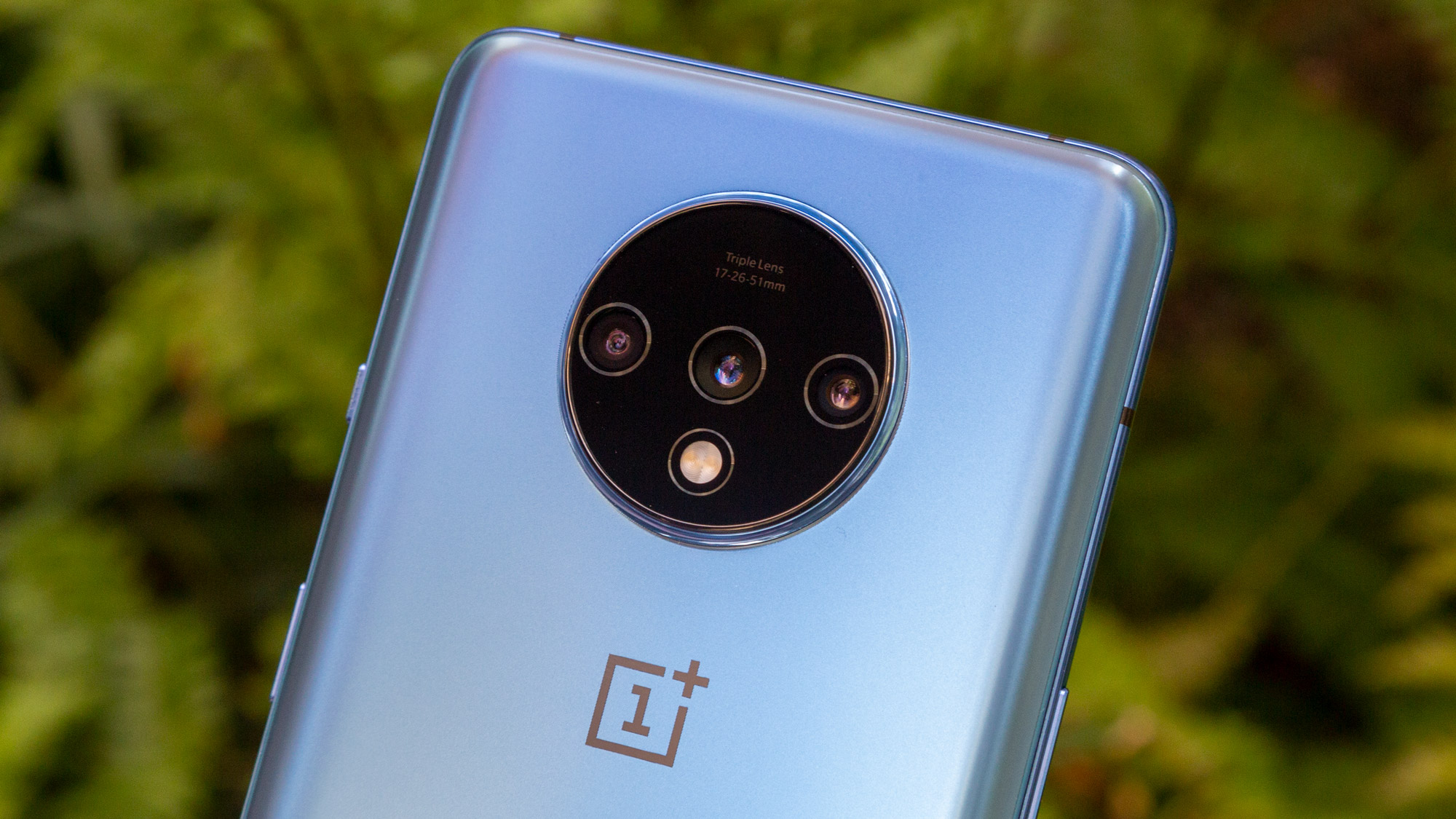
And yet, annoyingly, I still find my eyes repeatedly drawn to the OnePlus 7T’s gigantic camera hump — and not in a positive way. For one, it’s a bit obnoxious and gaudy, though I also worry about its durability. The camera housing occupies prominent space on the back, and that’s simply more glass that can be cracked or scratched, poking out from the rest of the hardware.
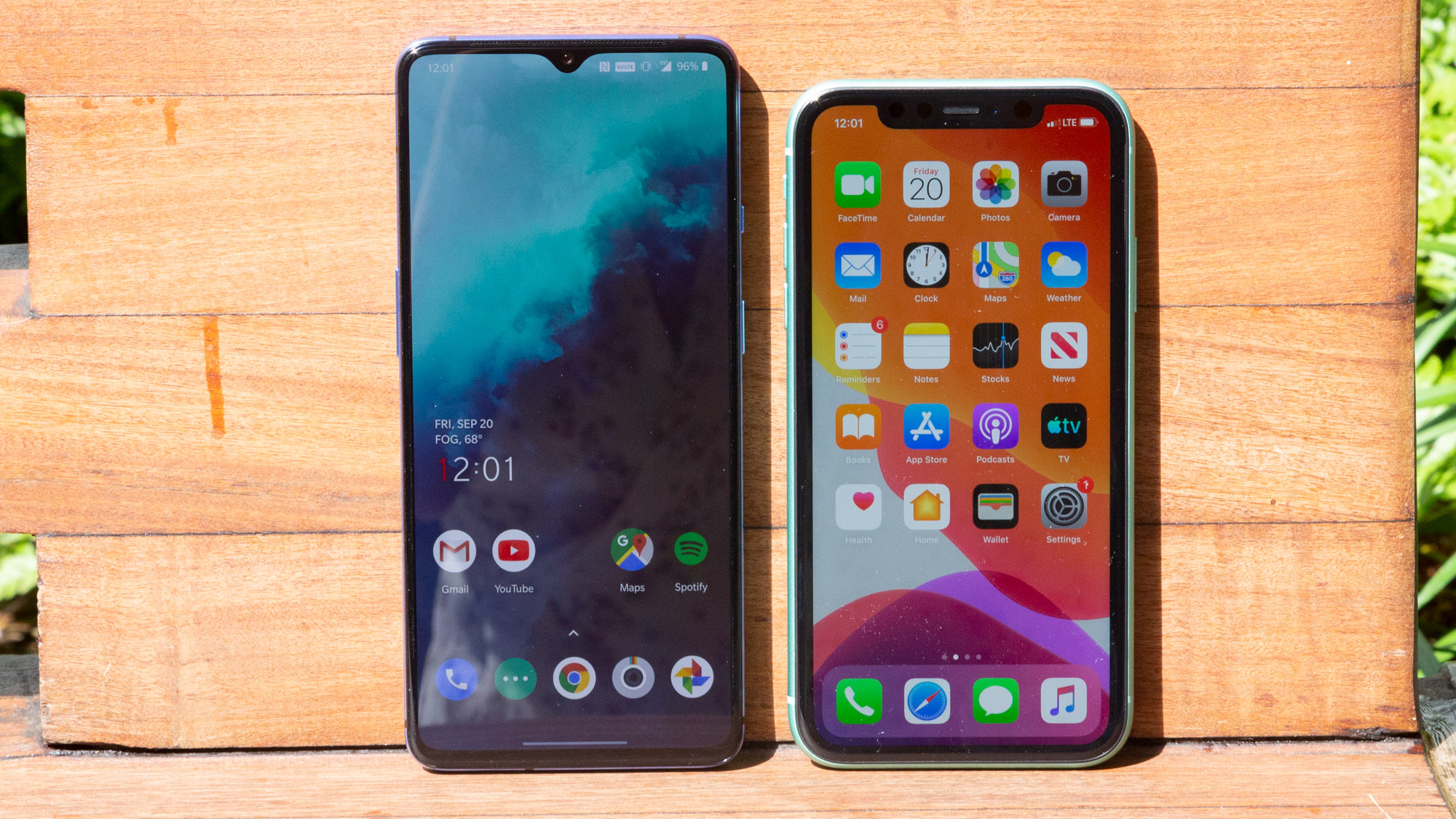
Yet again, I also find myself wishing that OnePlus would make a smaller phone for a change. The 7T’s 6.55-inch display is just two-tenths of an inch smaller than the 7 Pro’s. If the company has truly committed to a two-phone strategy, a cheaper device that is also more compact would make a lot of sense, and may broaden the range of appeal. The 7T might not be the largest phone in the world, but if you’re coming from an iPhone XS, Galaxy S9, S10 or Pixel 3, it will feel a bit unwieldy.
MORE: Best Phones of 2019
OnePlus is taking a familiar stance with the 7T’s water resistance in that it technically isn’t IP-certified, even though the company assures buyers it will stand up to an impromptu dunk or splash. One one hand, I kind of understand the rationale — IP testing drives up prices and besides, it’s not like IP-rated phones have water damage covered in their warranties. That said, you can’t put a price on peace of mind, and that’s exactly what IP ratings offer.
OnePlus 7T display: Everything should be 90Hz
OnePlus has a familiar refrain for the Fluid AMOLED display it introduced in the OnePlus 7 Pro earlier this year. I ask any OnePlus representatives reading this review to forgive any inaccuracies on my part, but it goes something like this: “Once you go 90Hz, you can’t go back.”
While I typically dismiss catchy marketing mottos, here’s the thing — this particular boast is absolutely right. The 6.55-inch, full-HD+ panel inside the OnePlus 7T is not the brightest we’ve come across, nor the sharpest. However, it’s easily my favorite I’ve used all year — and that includes the iPhone 11 Pro’s own Super Retina XDR panel — because of that silky-smooth refresh rate.
It’s hard to overstate the role animation plays in how our eyes and brains process responsiveness. Technically, at a physical level, it’s not like the 7T is really any faster to use than most other flagships you can buy today. But it truly feels like it is, thanks to that 90Hz panel.
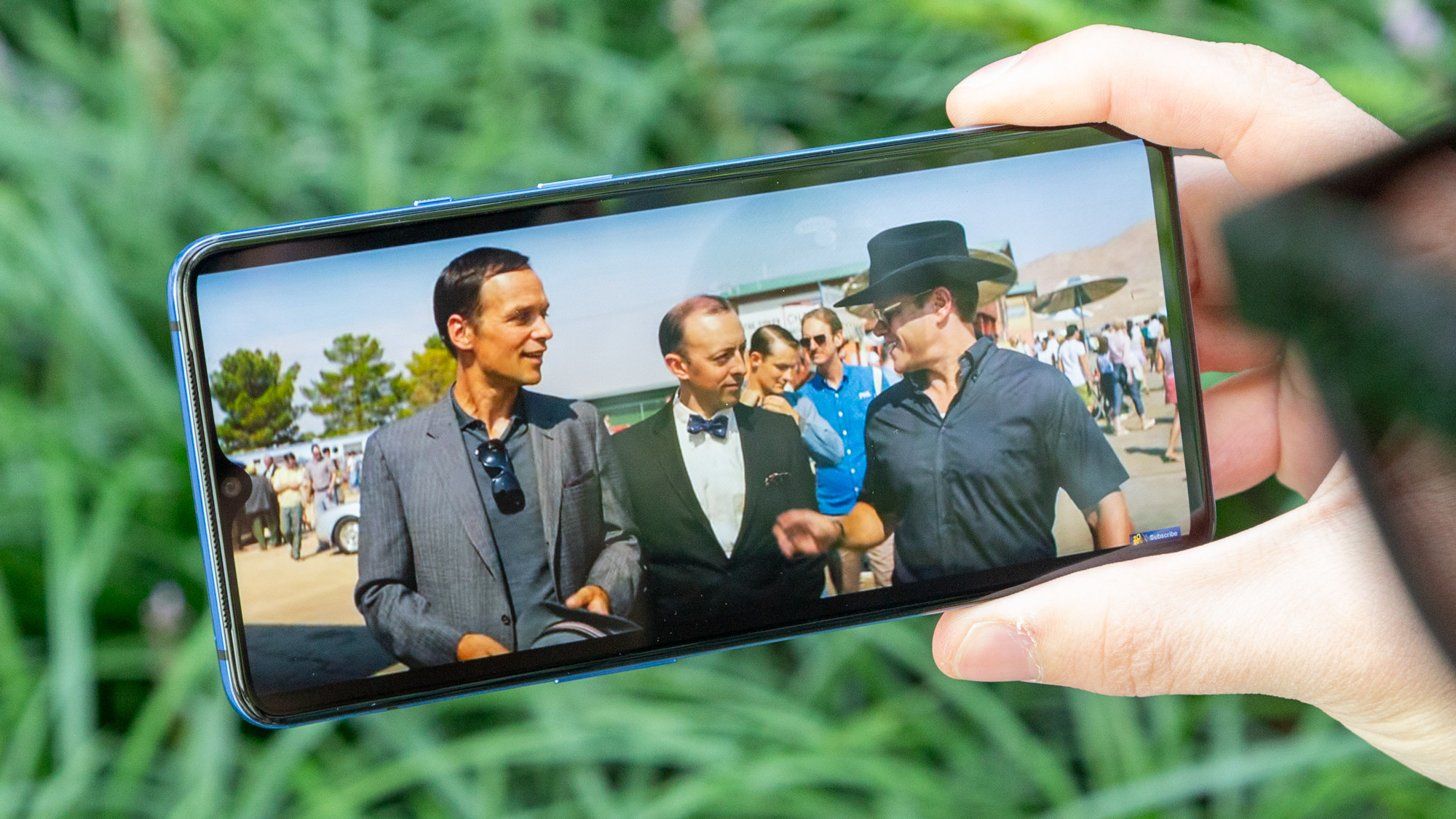
Thumbing around Android is simply a livelier experience at 90Hz. So too is gaming, for the few Android titles out there that can deliver higher frame rates. And that’s to say nothing of the 7T’s impressive HDR10+ color reproduction and the breadth of the choices it offers. Whether you prefer a more realistic DCI-P3 look or ultra-saturated hues emblematic of older OLED-powered phones, the 7T can be customized to suit your preference. There’s even a new chromatic Reading Mode that dulls colors for comfort, yet stops short of being complete grayscale.
It’s not like the OnePlus 7T is really any faster to use than most other flagship phones that you can buy today. But it truly feels like it is, thanks to the phone’s 90Hz panel.
I can live with the 7T’s peak 474 nits of full-screen brightness, which is admittedly far below the 652 nits of the Liquid Retina LCD-powered iPhone 11, as well as the Galaxy S10’s 611 nits. You could probably use that extra luminosity outside on the sunniest day, though in most circumstances, you’re not missing much.
When it comes to color accuracy, the 7T, set to its default Vivid color profile, delivered the same Delta-E score of 0.27 as the iPhone 11 Pro that we tested — indicating lifelike hues. And OnePlus’ 155.1% coverage of the sRGB color space shattered the iPhone 11 Pro’s 117.1%, which at least means you’ll get slightly more saturated colors out of the box with the 7T.
OnePlus 7T camera: Better, but not the best
The OnePlus 7T inherits the OnePlus 7 Pro’s primary, Sony-sourced, 48-MP sensor, as well as its 16-MP, 117° ultrawide shooter. A 12-MP telephoto, capable of 2x zoom, rounds out the repertoire on the back. The same 16-MP front-facing camera originally featured in the OnePlus 7 series looks back at you from a notch, rather than a motorized, pop-out mechanism like on the Pro model.

But, of course, these days it's never just a matter of optics. OnePlus tells us it has been continually improving the algorithms that power its UltraShot photography engine and Nightscape modes based on user feedback, too.
Based on the 7T’s attempt at rendering this picturesque late summer scene of Hudson Yards’ iconic Oculus, I’m inclined to believe them. While I ultimately prefer the warmer, more realistic colors of the iPhone 11’s attempt, as well as the way Apple’s handset more deftly neutralizes those brightest of highlights (like the reflection of the sun off the white sedan to the right), that big 48-MP sensor and ƒ/1.6 aperture still put up an excellent fight here. And because the 7T uses a Quad Bayer filter, the phone is actually binning four neighboring megapixels together for a 12-MP result that extracts more light out of your surroundings.
I came away equally impressed by the strength of the 7T’s ultrawide lens, which captured a picturesque view of lower Manhattan from the edge of Jersey City. For what it’s worth, the iPhone 11’s ultrawide shooter incorporates an even wider field of view than the 7T’s, which explains the relative difference in the sizes of the buildings when comparing the two shots. The iPhone 11 also teases more dynamic range out of the clouds above, providing a delicate gradient of grays and whites that adds a splash of contrast to the image.
The OnePlus 7T isn’t a replacement for high-end camera phones, but in many scenarios, it’s good enough.
To test out the 7T’s dedicated 2x optically-zooming telephoto lens, I honed in one of the buildings on the banks of the Hudson River. The iPhone 11 lacks a zoom camera — you’d have to spring for the $999 iPhone 11 Pro to make up for that — so, unsurprisingly, it cannot pull in anywhere near the same level of detail as the 7T in this particular comparison. Everything from the trees at the base of the building to the grid of metal frames and windows extending all the way to the sky is just so much sharper on the OnePlus handset.
That brings me to my favorite new feature on the 7T: Macro Mode. Like you’d expect, Macro Mode helps you peer in on the smallest of details, allowing you to capture pictures close up that would be rendered a blurry mess on any other device. While the perspective you can get with Macro Mode won’t fool anyone into thinking you’ve used a super-powerful DSLR lens, this feature is nonetheless very impressive.

We’ve all experienced the frustration of trying to snap a photo of something that’s just too small — perhaps a ladybug or something else out in nature. In trying to capture the image you see above, I was practically touching the petals of the flower with the back of the 7T I was using, and I was still able to get a relatively sharp result despite the circumstances. No other handset I’ve used can claim that, which is why I didn’t even bother sharing the photo I took with the iPhone 11 from the same vantage point in this review.
Unfortunately, I can’t lavish the same praise on the 7T’s bokeh-effect portraits. OnePlus’ attempt at a shot of my colleague Caitlin is thoroughly outmatched by the Galaxy S10’s rendition. Samsung’s handset plainly delivers cleaner details, more realistic color all around and a brighter overall image, which is surprising because both portraits were taken outside in broad daylight. What particularly disappoints me looking at the 7T’s shot is how it somehow managed to muddy up Caitlin’s hair — a pretty egregious error for an otherwise capable mobile shooter.
Finally, OnePlus' new and improved Nightscape mode does an admirable job of painting the late night Brooklyn scene you see above. The 7T's algorithms don't embolden edges unnaturally in the same way the S10's do, which makes the result from OnePlus' handset feel more lifelike and less stylized. That said, the 7T opts for a redder cast, which is particularly evident if you pay attention to the way the street lamp overhead colors the asphalt below. Samsung's lighting is definitely more accurate in that respect, making it difficult to pick a winner.
Ultimately, the OnePlus 7T isn’t a total replacement for the likes of the iPhone 11, Galaxy S10, or other high-end camera phones that we’ve tested this year. But in many scenarios, I think it suffices as good enough, certainly for a phone that costs less than $600.
OnePlus 7T performance: This phone flies
Here’s an unexpected discrepancy between the OnePlus 7T and 7 Pro: The newer, cheaper phone is actually faster than the latter model, because it packs Qualcomm’s latest Snapdragon 855 Plus system-on-chip.
The differences between the standard 855 and Plus models are slight, yet quantifiable. Both 855 chips comprise eight cores, with four of them designed for low-power tasks, and the other four geared for performance. Among those four is a Prime core with the fastest peak clock speed of them all, and it’s the Prime core that sees the biggest uplift in the 855 CPU — up from 2.84GHz to 2.96GHz.
Additionally, the 855 Plus’ Adreno 640 GPU is capable of 15 percent faster graphics rendering than the GPU inside the regular 855, thanks to a boosted clock speed there as well. The upshot of all of this is a phone primed for a superior gaming experience above all else.
Sure enough, while I didn’t notice a huge improvement playing PUBG Mobile, the OnePlus 7T’s 855 Plus silicon and 8GB of RAM was more than adequate to run the battle royale shooter at the highest possible frame rate and HDR graphics setting, with anti-aliasing and shadows switched on for good measure.
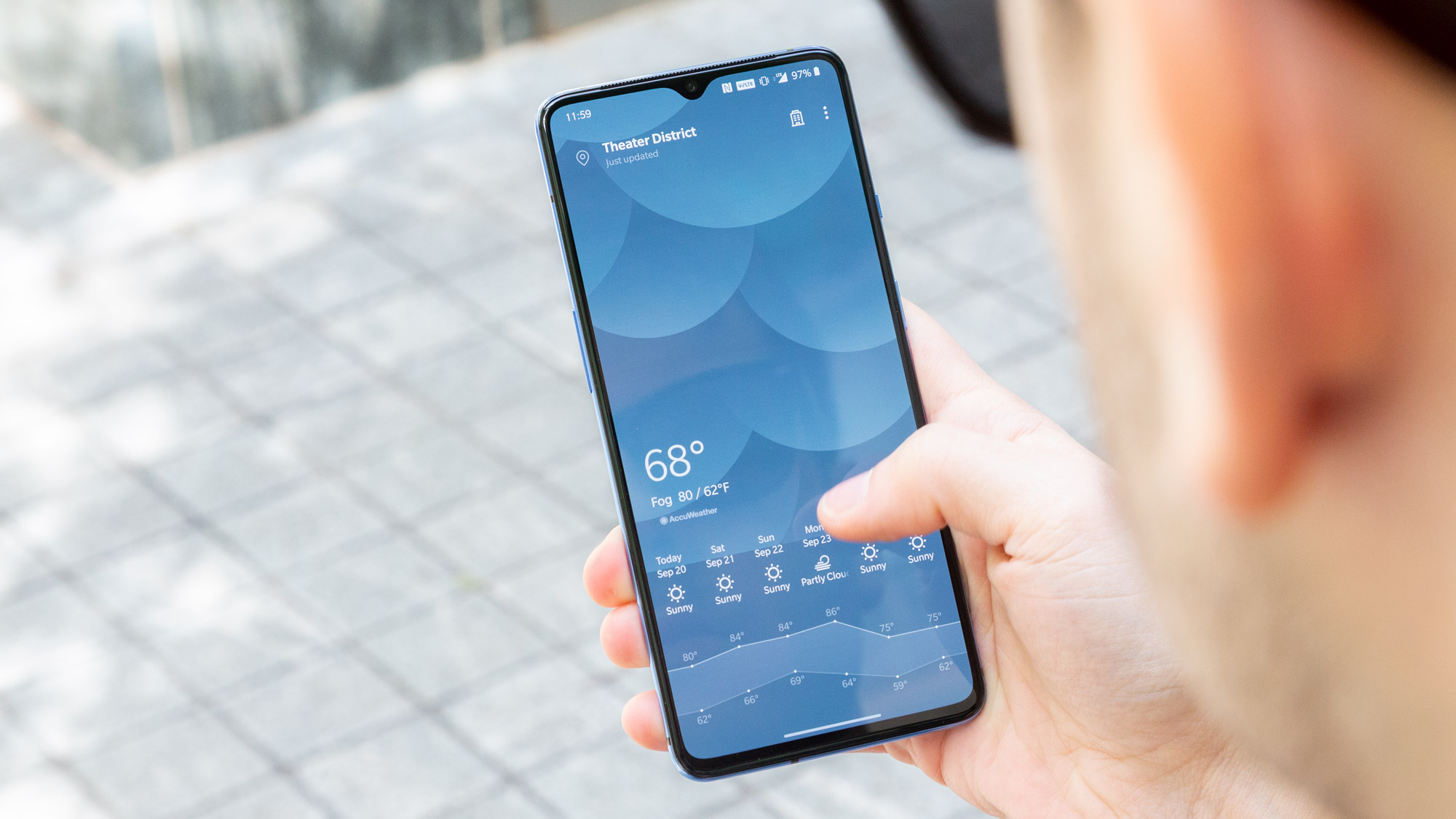
That’s not to say the phone didn’t get quite toasty under all that duress; after about five minutes of play, I needed to ratchet the frame rate down a peg just to continue playing comfortably. But rest assured, if you want to test the limits of that 90Hz display, the 7T has the muscle to do so — just remember, the price of the smoothest gaming experience is a hot handset.
In terms of benchmarks, Qualcomm’s snappiest chipset yet makes the OnePlus 7T among the fastest phones out there. In Geekbench 5, which measures overall system performance, the 7T notched a multicore score of 2,759 — more than 100 points higher than the Samsung Galaxy Note 10, yet a hair behind the 2,802 score of the OnePlus 7 Pro we tested earlier in the year, which benefited from 12GB of RAM — four more than the 7T’s 8GB.
MORE: Smartphones with the Longest Battery Life
As for comparisons against Apple’s latest iPhones, forget about it. The $699 iPhone 11 reached 3,251, while the $999 iPhone 11 Pro led with an astonishing 3,509 — even despite the fact both those phones contain half the RAM of the 7T. Even a tuned-up Snapdragon 855 can’t contend with the blistering pace of Apple’s A13 Bionic silicon.
We typically test graphics performance using 3DMark’s Sling Shot Extreme benchmark, though we couldn’t get it up and running on the 7T. However, we were able to conduct GFXBench’s Aztec Ruins off-screen test for high-tier devices, where the phone delivered 1,169 frames at 18 frames per second. The Note 10 got through 1,058 frames at 15 fps, while the iPhone 11 Pro again wiped the floor with both — 2,174 frames at 33.8 fps.
OnePlus 7T battery: Superfast charging, average life
The 3,800mAh battery inside the OnePlus 7T is 100mAh larger than the OnePlus 7's, but 200mAh smaller than what you get in the OnePlus 7 Pro.
However, the OnePlus 7T recharges more quickly than either of its predecessors, thanks to the company's new Warp Charge 30T protocol. While still pushing 30 watts of power, OnePlus said it's refined the circuitry inside the phone's battery and optimized the charging algorithm to achieve faster speeds than previously possible, using the very same brick the 7 Pro comes with out of the box.
By OnePlus' estimation, that means users should get to 70 percent, starting from zero, in just 30 minutes. We didn’t quite see that pace in our results — our unit reached just 61 percent with the stock adapter — though that’s still not too shabby, and at least consistent with the OnePlus 7 Pro’s performance.

In terms of battery life, the 7T put in 8 hours and 47 minutes of work in Tom's Guide's custom battery test, where phones endlessly cycle through websites at 150 nits of screen brightness until they run out of juice. Decent though that is, that's not only worse than the OnePlus 7 Pro (9:31); it pales significantly when compared to the iPhone 11 (11:20) and Samsung's Galaxy S10 Plus (12:35).
Why the relatively short endurance? The 7T's 90Hz display could have something to do with it, as a higher refresh rate increases power consumption. Of course, you can revert to the industry standard 60Hz if you are especially concerned about longevity, though, interestingly, OxygenOS' built-in battery saver mode doesn't automatically reduce the frame rate like you'd expect.
Oh, and one more thing — in true OnePlus fashion, the 7T also has no provisions for wireless charging. The company’s standard line against the feature in the past has been that it’s just not speedy enough for a good user experience. Yet that has begun to change in recent years, as companies like Samsung and Google have found ways to push more power over induction coils without damaging their devices. Here’s hoping OnePlus comes around on wireless charging sooner rather than later.
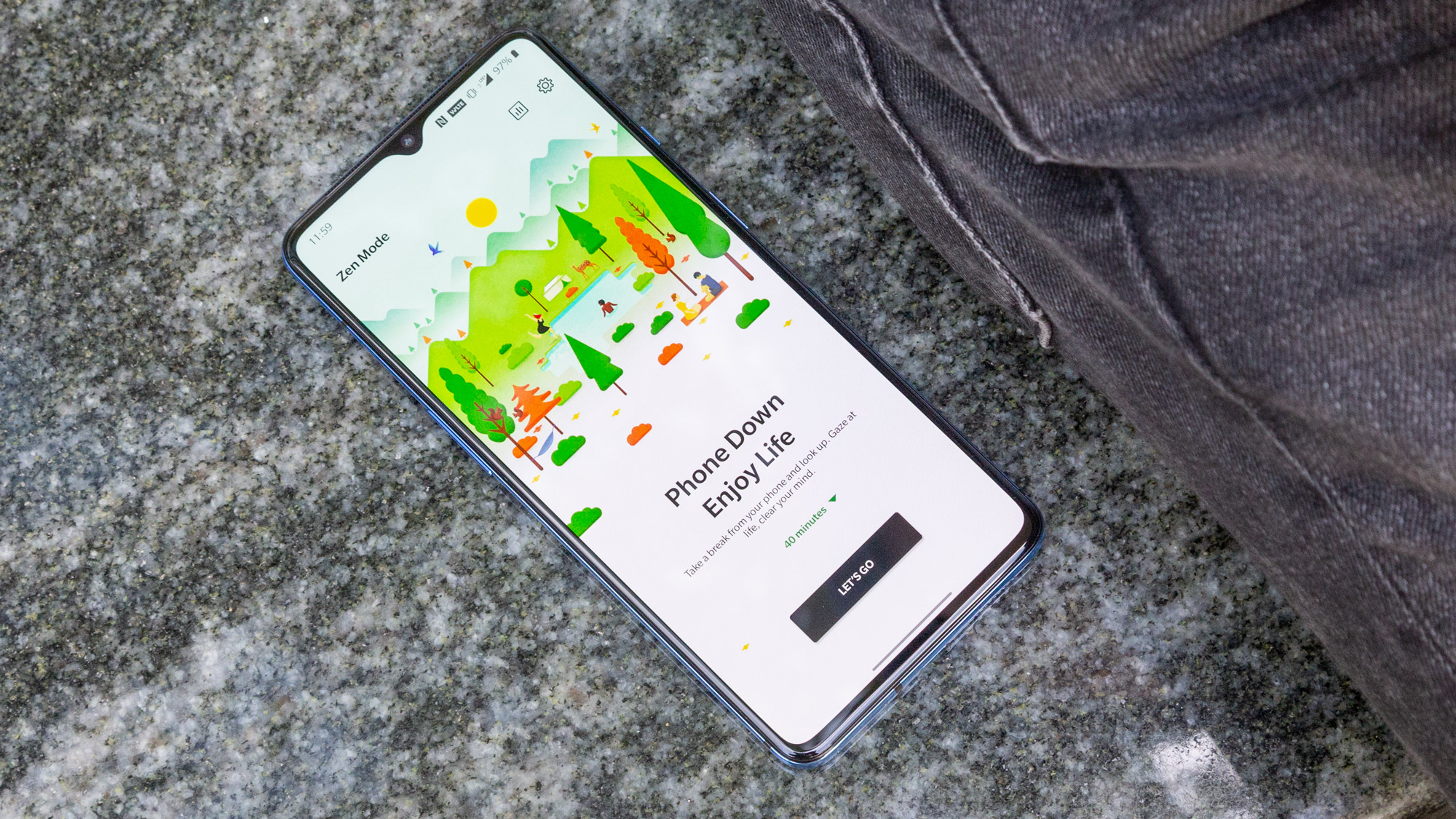
OnePlus 7T software: Android as you know it, supercharged
OnePlus is touting more than 370 major and minor improvements in OxygenOS 10.0, which range from a refreshed stock Gallery app, to improved algorithms enabling speedier and more secure Face Unlock and optical fingerprint sensor recognition, as well as an expanded Zen Mode that allows users to essentially lock their phone for everything except calls and camera access for up to an hour.
OxygenOS 10.0 is, of course, based on Android 10, so you also get all the improvements there, including a more intuitive gesture navigation system and Smart Reply in notifications for all chat apps, not just Google’s own.
The new gestures in particular are really clever, because OnePlus has actually improved upon Google’s new back motion, which requires a swipe inward from either side of the screen. On OxygenOS devices, performing this action within the top fifth of the display opens in-app menus — just like the gesture was originally designed to do — rather than sending you backward. It’s a brilliant way of bridging the gap between legacy and future Android, that doesn’t break the way software has traditionally functioned on the platform for years.
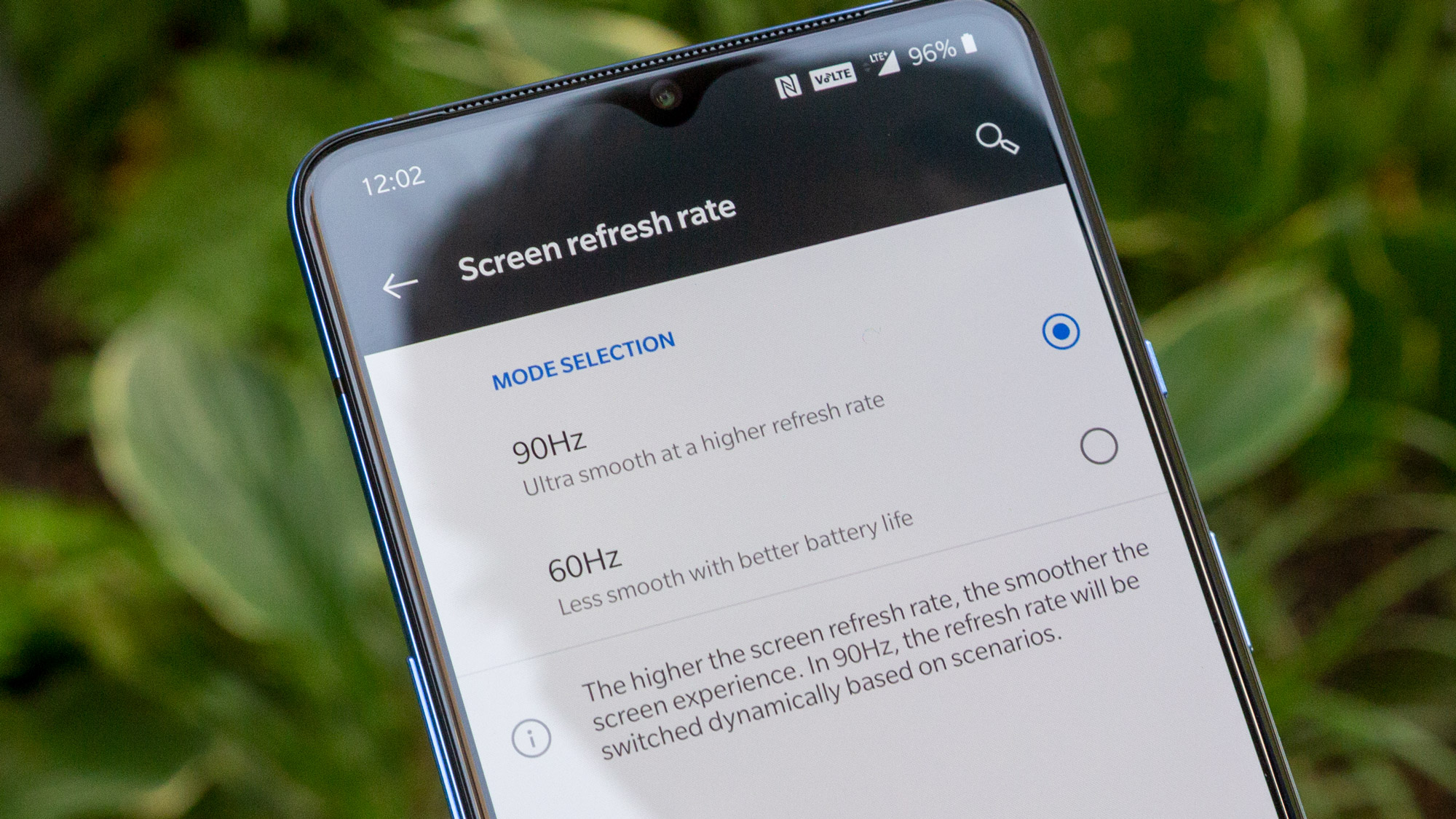
In fact, so many of OxygenOS’ little enhancements have left me, a Pixel user, preferring OnePlus’ interpretation of Android over Google’s. For example, Dark Mode has been available in OxygenOS for far longer than Google’s hacked-together-feeling solution, so it’s more consistent, and supports the entirety of OnePlus’ stock app suite.
And that’s to say nothing about extra features that have been kicking around in OxygenOS for years, like app encryption, the ability to capture scrolling screenshots, the separate drawer for hidden apps and Quick Launch, which essentially uses the in-screen fingerprint sensor as a springboard to shortcuts, if you continue long pressing after unlocking your phone.
Speaking of that fingerprint sensor, the optical reader underneath the 7T’s display is the fastest and most consistent I’ve encountered yet in a smartphone. That’s no small praise coming from me, as I tend to have the worst luck with in-screen scanners. The 7T’s is the first I’ve ever used that approaches the convenience and immediacy you get from those old-school capacitive modules.
Bottom line
The OnePlus 7 Pro might represent the pinnacle of the company’s product line at the moment, but the OnePlus 7T is the one I reckon most people on the hunt for an affordable Android flagship should buy.
I’m forever astounded by how OnePlus continually manages to undercut the competition by significant margins, while producing phones that don’t feel anywhere near as inexpensive as they cost.
The 7 Pro’s best feature — it’s 90Hz Fluid AMOLED display — is intact here, as well as its 48-MP main camera and ultrawide shooter. The 7T’s processor is faster than that inside any other premium Android handset this year, save for Asus’ ROG Phone 2. Even Google’s Pixel 4 is expected to ship with a less powerful CPU and less RAM. The 7T’s battery charges ludicrously quickly, and its computational photography — while not in the same class as Apple’s or Google’s — is still respectable for the price.
And price is a big advantage. The 7T costs just $599 — practically half what an iPhone 11 Pro with the same 128GB of storage goes for. You could certainly argue Apple’s range-topping iPhone is a better device. But twice as good? Not a chance.
I’m forever astounded by how OnePlus continually manages to undercut the competition by a significant margin, while producing phones that don’t feel anywhere near as inexpensive as they cost. You’d expect corners to be cut somewhere, but between the 7T’s meticulously-crafted software and feature-packed hardware, there’s no catch — just the best flagship bargain of the year.
Adam Ismail is a staff writer at Jalopnik and previously worked on Tom's Guide covering smartphones, car tech and gaming. His love for all things mobile began with the original Motorola Droid; since then he’s owned a variety of Android and iOS-powered handsets, refusing to stay loyal to one platform. His work has also appeared on Digital Trends and GTPlanet. When he’s not fiddling with the latest devices, he’s at an indie pop show, recording a podcast or playing Sega Dreamcast.
